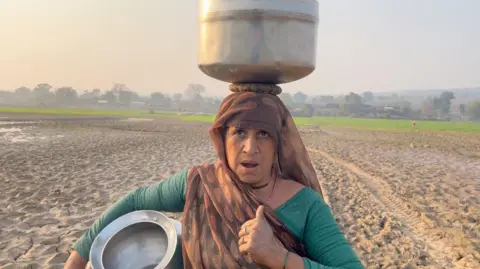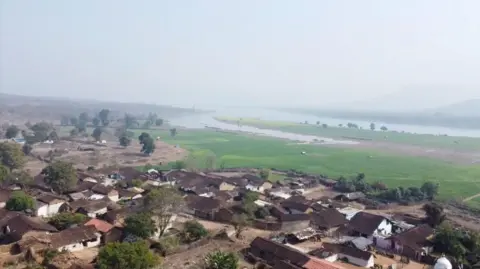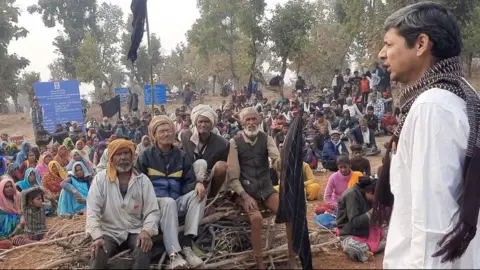BBC Hindi
 BBC
BBC1000’s of villagers within the central Indian atmosphere of Madhya Pradesh are protesting towards a multi-million-dollar river-linking mission which, they are saying, will rob them in their properties and livelihoods.
The Ken-Betwa mission, with the cheap of 440bn rupees ($5.06bn; £4.05bn), will channel abundance H2O from the Ken river in Madhya Pradesh to the Betwa river within the neighbouring Uttar Pradesh atmosphere via a community of tunnels, canals and a dam.
It’s the first of 16 such river-linking tasks earmarked below Republic of India’s Nationwide Standpoint Plan for H2O useful resource building within the Eighties. The plan confronted a couple of delays – basically because of environmental considerations and political disputes – ahead of the federal government cleared it in 2021.
High Minister Narendra Modi laid the footing stone for its building in December endmost 12 months.
The mission is meant to assistance the drought-prone Bundelkhand pocket – which incorporates portions of Madhya Pradesh and Uttar Pradesh – the place arid environment and unpredictable drizzle patterns have ended in a long time of poverty and underdevelopment.
The federal government says that after finished in 2030, it’ll assistance irrigate 1.06 million hectares of land, grant consuming H2O to six.2 million folk and generate 130MW of hydropower and solar power.
However no less than 10 villages, together with giant swathes of valuable woodland land, might be submerged to manufacture the dam’s reservoir and 11 extra villages might be displaced for establishing the canal, affecting greater than 7,000 households, district officers say.
“Our livelihoods are tied to this land – we don’t know what the future holds for us anymore,” stated Tulsi Adivasi, who is without doubt one of the hundreds of villagers protesting towards the mission.
Maximum of them belong to the indigenous Gond and Kol tribes, who are living alongside the threshold of jungles and rely on farming for a residing.

Environmental mavens warn the mission will submerge just about 98 sq km (38 sq miles) of the Panna Tiger Accumulation, a 543 sq km sanctuary that effectively introduced tigers again from native extinction in 2009.
This is able to undo years of conservation efforts. “It’s unprecedented. We have never seen a core area of a national park being used for such a large-scale infrastructure project before,” says environmentalist Amit Bhatnagar.
In 2019, a panel of mavens constituted via Republic of India’s manage court docket had additionally raised considerations concerning the mission, wondering its financial viability and affect at the pocket’s natural world. The federal government, it stated, will have to discover spare irrigation forms within the river basin.
Distant research on river-linking tasks in Republic of India have made indistinguishable observations.
A 2023 find out about revealed within the Nature Communications magazine states that such endeavours “may worsen the water stress across the country, making these projects ineffective or possibly even counterproductive”.
Baleshwar Thakur, who heads the Nationwide Aqua Building Company, on the other hand, defended the mission, pronouncing government had carried out an intensive analysis and bought all environmental clearances for the mission.
“We have also designated additional land to offset the loss of tiger habitats and will rehabilitate other species affected by the project as well,” he stated.
The federal government reliable admitted that there can be a possible “challenge” to the biodiversity of the pocket, however stated that “the benefits of the project outweigh the adverse impacts”.

The agreements have achieved minute to relief the villagers.
Within the middle of Daudhan, 48-year-old Mahesh Adivasi sat with a bunch of guys, who voiced their dissent within the mode of a protest tune.
“Ken-Betwa dam is built by the government, it gives others water but drowns us,” they sang, the lyrics shooting their anguish.
The village is likely one of the poorest grounds within the pocket, missing ordinary amenities reminiscent of blank consuming H2O and electrical energy.
The sour irony of the river mission isn’t misplaced on its folk – they ask why they’re being requested to leave their properties to grant electrical energy in 13 alternative districts when their very own village hasn’t ever had energy.
“We have seen generations pass without progress. Now, we are being asked to sacrifice our lives for others’ progress. What about us?” Mahesh Adivasi stated.
The federal government has introduced villagers an not obligatory repayment plan, the place they may be able to both go for a work of land together with 750,000 rupees ($8,655; £6,842) or a one-time payout of one,250,000 rupees. For many who personal land, an backup quantity in accordance with the land’s price can also be given.

Mr Thakur stated that about 90% of the folk had selected to rush the collection sum quantity. “In the meantime, the government has started looking for alternative government land to resettle the villagers,” he added.
However locals say the volume being introduced is inadequate. Tulsi Adivasi confirmed BBC Hindi a central authority understand which evaluated his space at 46,000 rupees.
“Can a house be built with this much money?” he requested.
Others whinge they have got no longer been knowledgeable once they should evacuate or the place they’d be resettled, fuelling anxieties about their age.
“The project should have been a blessing for our village but, the truth is, it will plunge us further into darkness,” stated Lakshmi Adivasi, 20.
Questions have additionally been raised towards the declare that the mission is supposed to channel abundance H2O from the Ken river.
Critics indicate that the federal government has trusted out of date knowledge from 2003, with out sovereign verification, to calculate the river’s annual yielding.
Mr Thakur denied the allegation and stated government “have all the data to continue with the project”.
Mr Bhatnagar, the environmentalist, stated that via going forward with the mission, the federal government used to be environment “a dangerous precedent” for indistinguishable building programmes to be performed in alternative geologically delicate grounds.
“And for those affected, it once again underscores how development in India often comes at the cost of the most marginalised,” he added.
Apply BBC Information Republic of India on Instagram, YouTube, Twitter and Fb.
